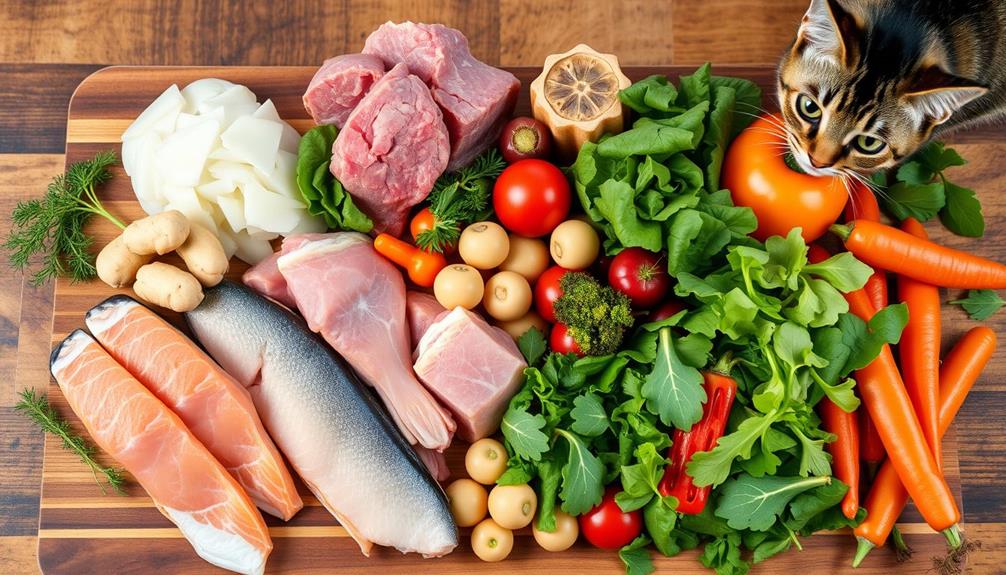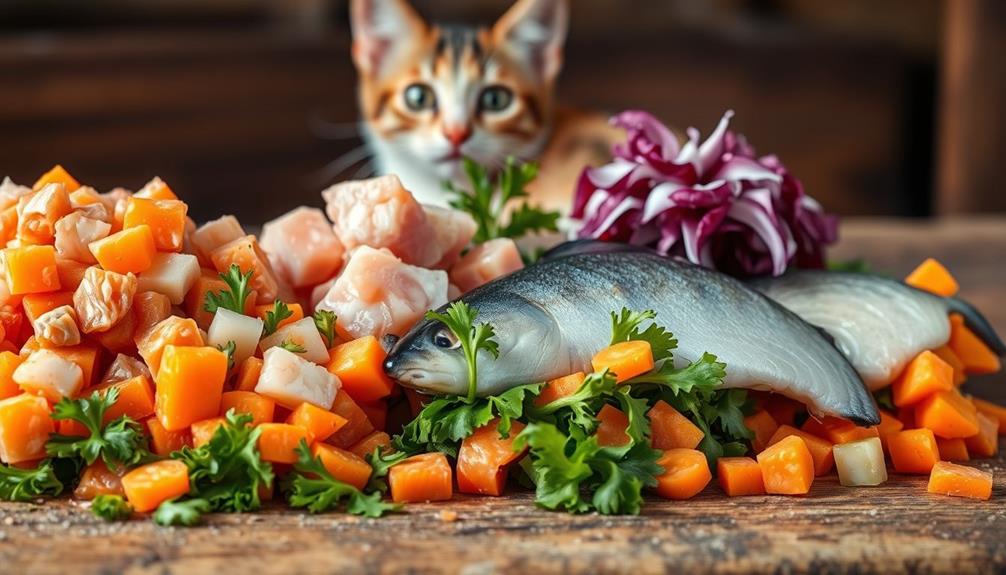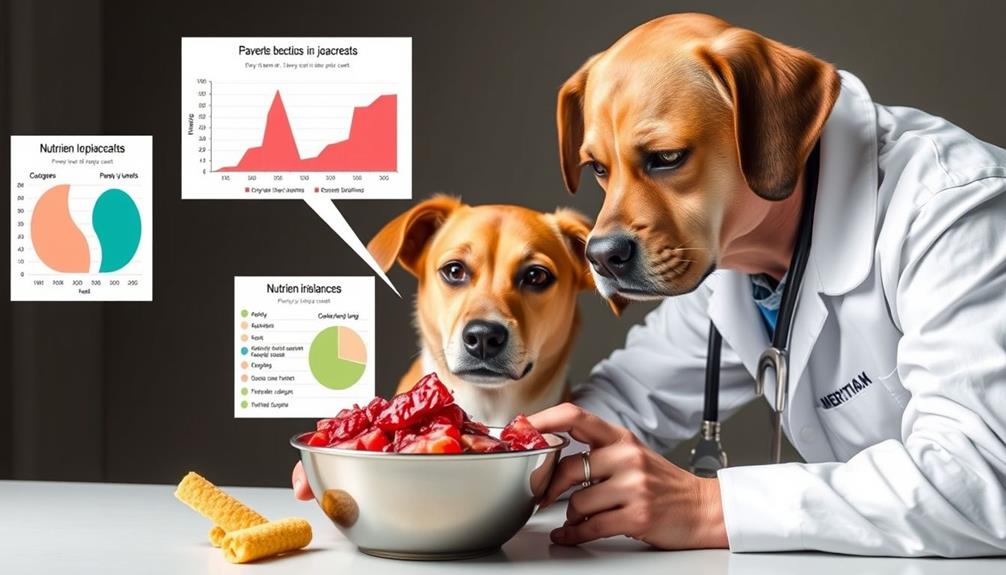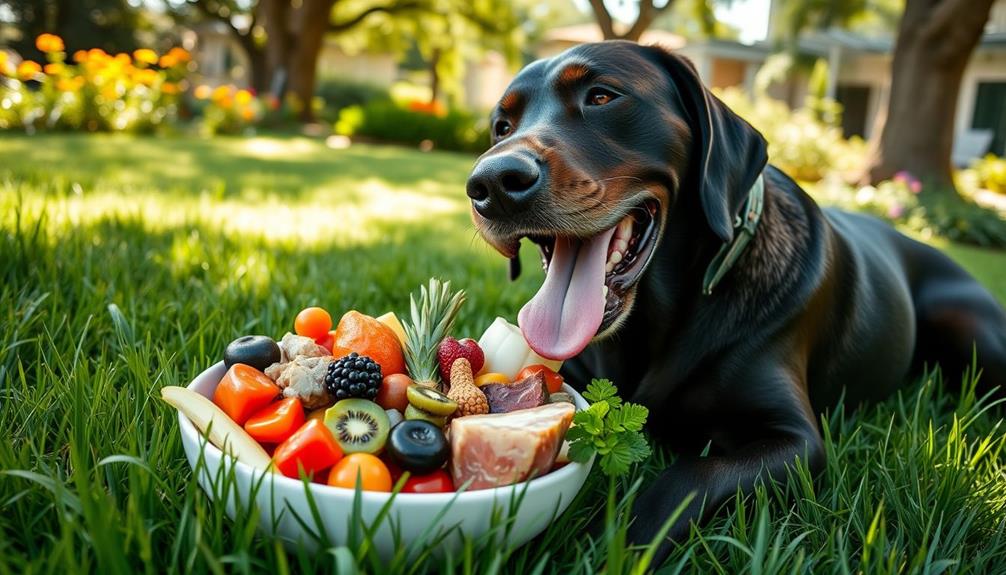If you're considering a raw food diet for your cat, focus on high-quality meats like raw chicken, turkey, ground beef, and fish. These provide essential proteins, vitamins, and healthy fats, helping to maintain your cat's energy and coat condition. Aim for a balance of about 83-85% meat, 7-10% bones, and 5-10% organ meat for ideal nutrition. Remember to source your meats from reputable suppliers and practice proper storage and handling to reduce risks of contamination. Interested in the best ways to shift your cat to a raw diet? There's plenty more to explore!
Key Takeaways
- Raw chicken is high in protein and essential vitamins, making it an excellent staple for cat diets.
- Turkey is a lean meat option that supports weight management and muscle health in cats.
- Ground beef provides iron and amino acids, contributing to overall energy and muscle maintenance.
- Fish is rich in omega-3 fatty acids, promoting healthy skin and a shiny coat for cats.
- Balance various meats in the diet to ensure a well-rounded nutrient profile for optimal feline health.
What Is Raw Food for Cats?
Raw food for cats refers to a diet that consists mainly of uncooked muscle meat, organ meat, and ground bones, mimicking what wild felines eat in their natural habitat. As obligate carnivores, cats thrive on a diet rich in raw meat. A raw food diet aims to meet their nutritional needs by providing protein, fats, and vital vitamins and minerals.
Proper diet considerations for pets, including cats, can be found in resources like ultimate care guides. Common meats in these diets include chicken, fish, and turkey, but you can vary the protein sources to add diversity.
However, while raw diets may seem appealing, they come with potential risks. It's important to guarantee that the diet offers complete and balanced nutrition, as deficiencies could arise if not carefully planned.
The nutritional adequacy of commercial raw cat food is a hot topic among experts. Agencies like the FDA and CDC warn against raw diets due to health concerns, including the risk of bacterial contamination from pathogens like Salmonella and E. coli.
Consequently, if you're considering feeding cats a raw food diet, it's vital to weigh the health benefits against these risks and approach preparation and handling with caution.
Benefits of Raw Food

One of the key advantages of feeding your cat a raw food diet is the high protein content, which supports muscle health and provides the energy they need as obligate carnivores.
When you choose a raw cat food diet, you'll likely notice several benefits of raw food for your feline friend, including:
- High in Protein: Raw meat offers essential amino acids that help maintain your cat's strength and vigor. Additionally, incorporating raw food into your cat's diet may enhance their overall health, as these foods are often rich in antioxidants, similar to how cranberry juice consumption can benefit humans.
- Skin and Coat Health: The natural fats and nutrients found in fresh animal products enhance your cat's skin and coat, making it shiny and healthy.
- Better Digestion: Raw diets often promote improved digestion, as the natural enzymes in raw food aid in breaking down nutrients effectively.
- Oral Health: Chewing raw meat and bones can help keep your cat's teeth and gums clean, reducing plaque buildup.
Additionally, raw diets typically have higher moisture content than dry kibble, encouraging better hydration.
Plus, raw fish is rich in omega-3 fatty acids, which are beneficial for maintaining a healthy skin and coat condition.
Nutritional Balance in Raw Diets
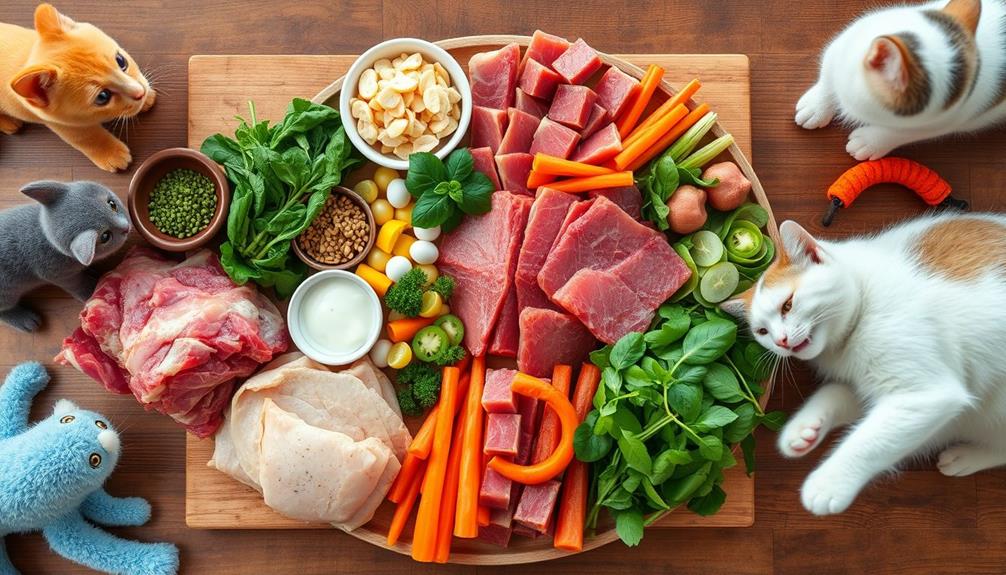
Feeding your cat a raw food diet requires careful attention to nutritional balance to guarantee they receive all the necessary nutrients for peak health.
A balanced raw diet typically consists of 83-85% raw meat, 7-10% edible bones, and 5-10% organ meat, with half of the organ meat being liver. This mix assures your cat gets essential nutrients like taurine, arachidonic acid, and vitamins A, D, and B, which are critical for avoiding deficiencies that could lead to serious health issues.
It's also important to take into account natural remedies that can enhance your cat's overall health. Nutritional adequacy can vary greatly between homemade and commercial raw cat foods, so it's essential to formulate these diets to meet AAFCO nutrient profiles.
Incorporating a variety of protein sources is also important; aim for at least 4-5 different types over time, as this provides a broader spectrum of essential nutrients.
Additionally, monitoring the ratios of calcium and phosphorus in the diet is essential. An improper balance can lead to skeletal health problems, especially in growing kittens and aging cats.
Safety of Raw Food for Cats
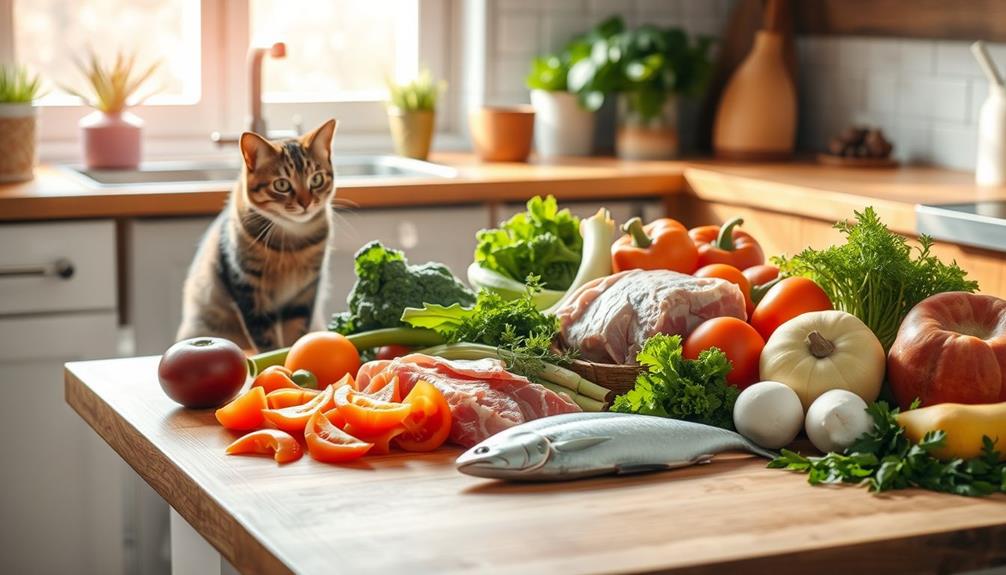
When considering a raw food diet for your cat, it's vital to understand the risks of bacterial contamination.
Making certain your cat receives a balanced diet is essential for their overall health and longevity, similar to how budgeting is essential for financial health.
You need to follow proper handling techniques and make certain safe sourcing of ingredients to keep both your pet and your household healthy.
Bacterial Contamination Risks
Raw cat food carries significant risks of bacterial contamination that pet owners should be aware of. Feeding your cat raw meat can expose both your pet and your household to harmful bacteria like Salmonella and E. coli, which are serious foodborne pathogens.
The importance of maintaining hygiene is vital, similar to the privacy policies that outline data handling practices. Here are some key risks to take into account:
- Contamination: USDA estimates suggest that about 25% of raw chicken parts may harbor these pathogens.
- Parasites: Toxoplasma gondii and other parasites can also be present in raw foods, increasing health risks.
- Short-term tolerance: While healthy cats have short, acidic stomachs that can tolerate some bacteria, it doesn't mean they're immune to illness.
- Increased dangers: The potential for foodborne illnesses remains significant, underscoring the need for caution.
To minimize these risks, it's important to practice proper handling hygiene. This includes thoroughly cleaning your hands, surfaces, and utensils after they come into contact with raw meat.
Proper Handling Techniques
To guarantee your cat's safety while handling raw food, it's essential to prioritize proper hygiene practices. Start by washing your hands thoroughly with soap and water after any contact with raw cat food. This helps prevent bacterial contamination that can lead to foodborne illness.
All surfaces and utensils that come into contact with raw meat should be cleaned and disinfected immediately. This avoids cross-contamination with other foods. When it comes to raw meat storage, keep it in the refrigerator for no more than 2-3 days, or freeze it for up to one year at 0°F or lower to maintain freshness and safety.
When you need to defrost raw meat, do it in the refrigerator or in cold water—never at room temperature. Avoid rinsing raw meat, as this can spread harmful bacteria onto kitchen surfaces and utensils.
Here's a quick reference table to help you with proper handling techniques:
| Action | Best Practice | Purpose |
|---|---|---|
| Wash your hands | After handling raw food | Prevent bacterial contamination |
| Clean and disinfect | Surfaces and utensils | Avoid cross-contamination |
| Raw meat storage | Refrigerate or freeze | Maintain freshness and safety |
| Defrost raw meat | Refrigerator or cold water | Minimize bacterial growth |
| Avoid rinsing raw meat | Don't rinse | Prevent spreading bacteria |
Safe Sourcing Practices
Sourcing high-quality raw food for your cat is essential for their health and safety. To guarantee you're practicing safe sourcing, follow these key steps:
1. Choose reputable suppliers: Select sources that offer high-quality meats and have certifications that meet food safety standards.
It's important to regard the value of home security systems in order to protect your home and the food you purchase for your pets.
2. Check for freshness: Always inspect raw meat for signs of spoilage or contamination risks. Freshness is key to avoiding harmful bacteria like Salmonella.
3. Practice proper storage: Keep raw food frozen until you're ready to use it. Thaw it safely in the refrigerator or under cold water to minimize bacterial growth.
4. Monitor expiration dates: Regularly check the expiration dates and storage conditions of raw food products. Discard any items that show signs of spoilage.
Best Raw Meats for Cats
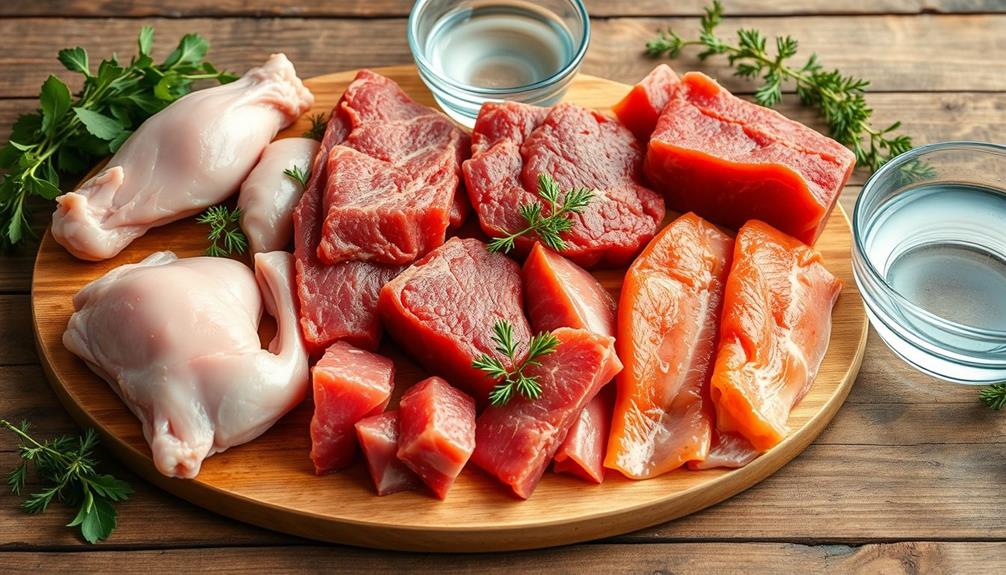
When choosing raw meats for your cat, it's crucial to take into account their nutritional value.
You'll want to focus on safe meat options like chicken, turkey, and fish, which provide key nutrients for your cat's health.
Additionally, incorporating high-quality protein sources can improve your cat's energy levels and overall wellness.
Understanding these choices helps guarantee your feline friend gets a balanced and beneficial diet, which is similar to how healthy dog snacks benefit dogs.
Nutritional Value of Meats
Choosing the right raw meats for your cat is important for their health and well-being. When you select high-quality meats, you provide your feline friend with crucial nutrients that support their overall health. Incorporating fresh ingredients can enhance their diet and prevent potential health issues, making it necessary to choose meats wisely.
Here are some of the best options:
- Raw Chicken: High in protein and important vitamins like B6 and B12, it boosts your cat's health and energy.
- Turkey: A lean meat that's low in fat, it's perfect for weight management and helps maintain muscle mass.
- Ground Beef: Packed with iron and amino acids, it supports muscle health and offers a great energy source for active cats.
- Fish: Rich in omega-3 fatty acids, particularly salmon, it promotes healthy skin and a shiny coat while providing potassium and B vitamins.
Incorporating these meats into your cat's diet enhances their nutritional value. Each option delivers important vitamins and amino acids that contribute to their well-being.
Remember to balance these meats in their diet for best health benefits, as even natural sources can benefit from essential oil combinations that support overall wellness.
Safe Meat Choices
Selecting safe meats for your cat is essential to confirm they receive the right nutrients without compromising their health.
When considering raw food for cats, chicken is a top choice. It's high in protein, selenium, niacin, and vitamins B6 and B12, providing a well-rounded diet for your feline friend. Additionally, incorporating essential oils for respiratory health can support your cat's overall wellbeing.
Turkey is another excellent option, being lean and low in fat, which is great for cats that need to manage their weight.
Beef can also be included in your cat's diet, rich in iron and amino acids that support muscle health. However, it should be fed in moderation due to its higher fat content.
Lamb offers heme iron and vitamin B12, but like beef, it's best to serve it sparingly to avoid excess fat.
Lastly, fish, particularly salmon, is an outstanding addition. It's packed with omega-3 fatty acids, potassium, and B vitamins that promote healthy skin and a shiny coat.
Transitioning to a Raw Diet
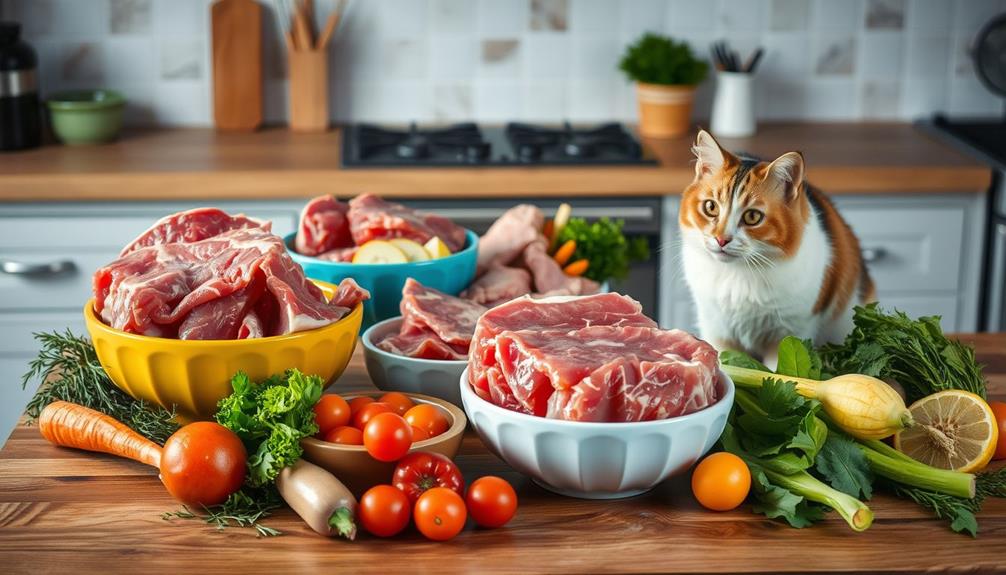
Shifting to a raw diet can be an exciting journey for both you and your cat, but it requires careful planning and patience. To guarantee a smooth changeover to a raw diet, follow these steps:
1. Start Gradually: Begin with a mix of 25% raw foods and 75% of your cat's current diet.
Increasing the raw proportion by 25% every few days can help your cat adjust better to the new diet.
It's important to monitor their health closely, just as you'd for any other dietary changes.
proper aftercare is essential for overall well-being.
2. Monitor Closely: Keep an eye on your cat's health during this process.
Look for any signs of digestive upset, especially in adult cats.
3. Consult a Veterinarian: Get personalized guidance from your vet, particularly if you have a kitten, older cat, or one with existing health issues.
4. Assess Regularly: Evaluate your cat's health and acceptance of the new diet throughout the changeover.
Make adjustments as needed.
Alternatives to Raw Meat
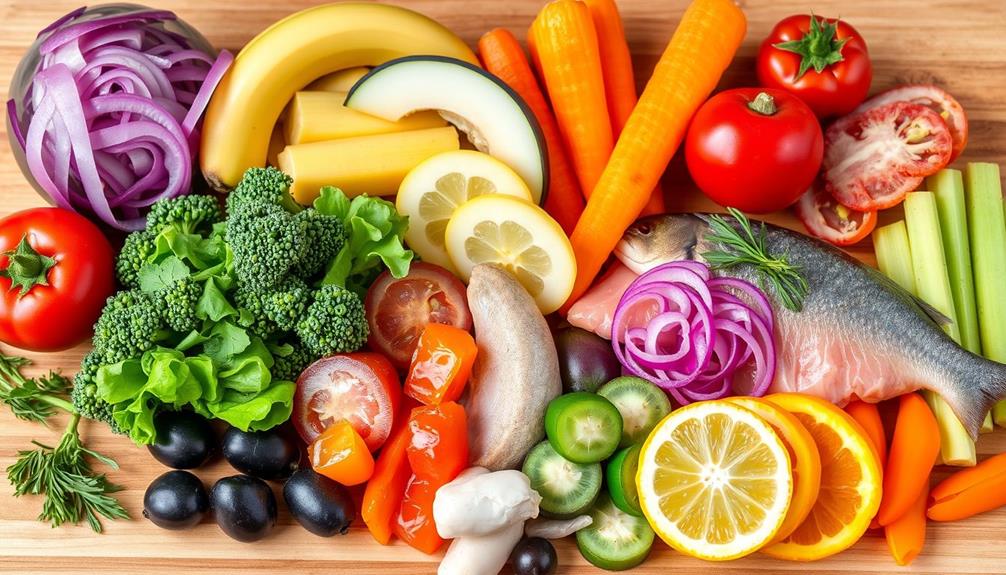
As you explore raw diets for your cat, it's important to contemplate alternatives that can still provide the necessary nutrients without the risks associated with raw meat. Numerous options exist that offer balanced nutrition while ensuring safety.
| Type of Food | Description |
|---|---|
| Commercial Raw Diets | Pre-packaged raw diets, balanced and formulated by veterinarians. |
| Cooked Meat Options | Steamed or boiled meats like chicken or turkey for high-quality protein. |
| Freeze-Dried Options | Retain nutrients of raw ingredients while eliminating bacteria. |
You can also consider high-quality wet cat food, which offers hydration and essential nutrients in a palatable format. If you prefer something convenient, dry cat food is another option. Many kibble products are commercially prepared to meet nutritional standards, ensuring your cat receives balanced nutrition.
These safe alternatives provide flexibility in your cat's diet while maintaining the quality they need. Whether you choose cooked food, freeze-dried options, or commercial raw cat diets, these choices can help support your cat's health without the risks associated with raw meat.
Handling and Storage Tips
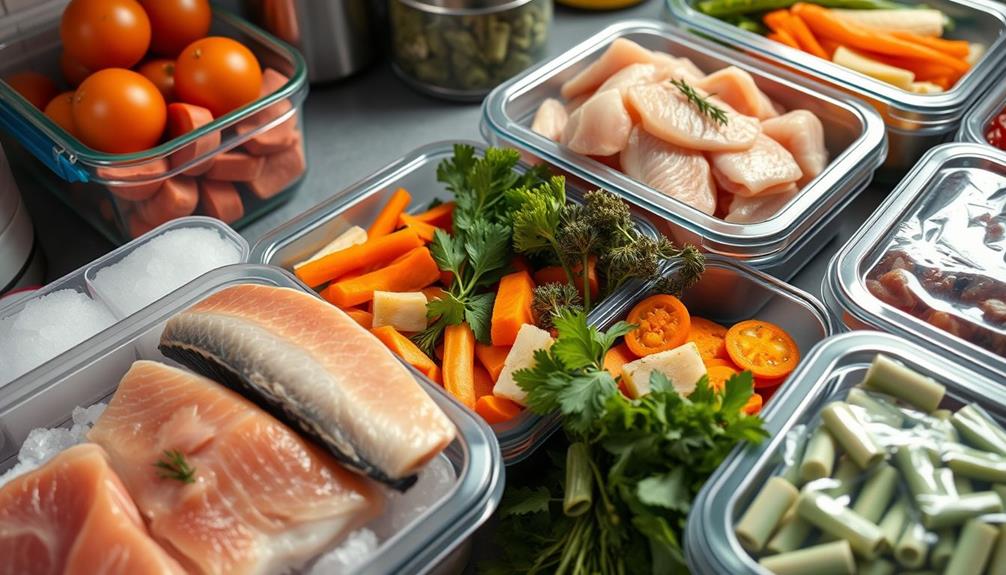
Proper handling and storage of raw food is essential to guarantee your cat's safety and health. Here are some key tips to follow:
- Storage: Keep raw meat in the freezer until you're ready to use it. It can last up to one year at 0°F or lower, ensuring freshness and safety.
- Defrosting: Always defrost raw meat in the refrigerator or by using cold water. Avoid room temperature to prevent bacteria from growing.
- Refrigeration: Once thawed, refrigerated raw meat should be used within 2-3 days to prevent spoilage and maintain food safety.
- Cleaning: After handling raw cat food, clean all surfaces, utensils, and your hands thoroughly with soap and water to prevent cross-contamination.
Frequently Asked Questions
What Is the Healthiest Raw Food for Cats?
The healthiest raw food for your cat includes high-quality muscle meats like chicken and turkey, nutrient-rich organ meats, and ground bones for calcium. Make certain you're providing a balanced diet tailored to their nutritional needs. Additionally, it’s important to incorporate a variety of raw food for cats, such as fish and eggs, into their diet to ensure they’re receiving a wide range of nutrients. Avoid relying solely on one type of protein and instead, rotate different options to promote overall health. Remember to consult with a veterinarian or animal nutritionist to ensure you’re meeting all of your cat’s dietary requirements when feeding raw food for cats.
Do Vets Recommend a Raw Diet for Cats?
Vets usually don't recommend raw diets for cats due to health risks and nutritional concerns. They emphasize balanced nutrition, safety, and the importance of vet guidance to guarantee your feline's well-being and nutritional needs are met.
What Can I Feed My Cat With Raw Food?
You can feed your cat raw meats like chicken, turkey, and beef, along with organ meats for nutrients. Incorporate raw meaty bones carefully and consider fatty fish like salmon in moderation for added health benefits.
Do Cats Live Longer on a Raw Diet?
Cats don't necessarily live longer on a raw diet. While some believe it improves health, the evidence isn't strong. Factors like genetics and overall diet quality play a bigger role in their lifespan.
Conclusion
In summary, embracing a raw food diet for your cat can be like opening a treasure chest of health and vitality. By choosing the right meats and ensuring nutritional balance, you can watch your furry friend thrive with energy and joy. Just remember to shift slowly and handle their meals with care, treating them like the precious gems they are. With a little effort, you'll be giving your cat a vibrant, natural lifestyle that shines brightly in their eyes.

